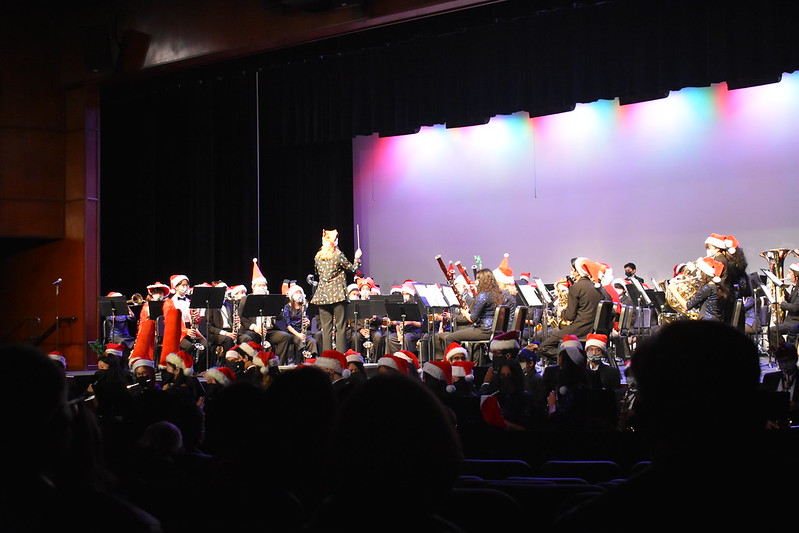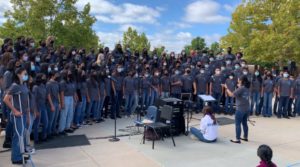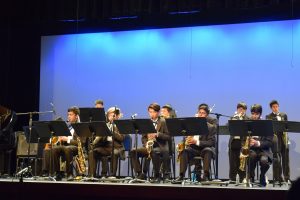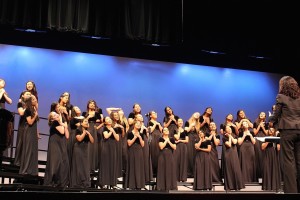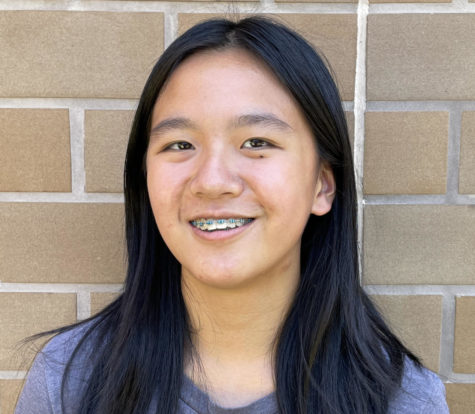DVHS bands honor the 80th anniversary of the Pearl Harbor attack at their annual winter concert
Ending the winter concert on Dec. 7 with a bang, Symphonic Band 1 and the two Wind Ensembles, along with Band Director Teri Musiel, changed into festive attire to perform their last song “Sleigh Ride” together.
January 19, 2022
On Dec. 7, DVHS band began the first of their two-day winter concert, showcasing astounding versatility and hopeful indicators of an exciting musical year to come.
The concert, which featured Concert Band 2, Symphonic Band 1, and both Wind Ensembles, played to a captive audience filling most of the house. Alongside the obligatory winter holiday pieces, the repertoire also took on a more commemorative note: Dec. 7 was the 80th anniversary of the attack on Pearl Harbor, and with a touching acknowledgment from Band Director Teri Musiel, the band’s pieces paid a fitting tribute to this occasion.
Concert Band 2 kicked off the night promptly at 7 p.m. with band teacher Marc Walker at the helm. He conducted the band in their first piece, “Critical Mass”, and the pleasant atmosphere of the audience was almost comically disturbed when the piece started right off with a dissonant, hair-raising roar from all the instruments. They settled down into the forward chug of a driving brass engine accentuated by drum beats and a haunting woodwind melody before culminating in a triumphant finish. The audience got the idea: pay attention to these freshmen — they’re not here to mess around.
Their next piece, “Summer Song”, was the definite highlight of the Concert Band program: pretty embellishments from the xylophone touched off the harmony of all the other instruments that evoked the nostalgia of carefree summer days, and there were even reggae beach beats dispersed throughout the calm, happy melody. It was a great song choice to transport listeners out of their wintertime melancholy, and the unified playing hinted at great potential for the freshman band.
Musiel, taking the conductor’s box permanently, conducted the last of Concert Band’s pieces, which began with “Winter Holiday”, setting a fitting seasonal contrast to “Summer Song” through a festive holiday medley. The bouncy pep of “Let it Snow” flowed into a more wistful, melancholy tune, as if one was peering out the window in a winter cottage, before ending in the upbeat forte of “Frosty the Snowman.”
While acknowledging some of the concert’s mishaps, Musiel wanted to recognize Concert Band for rising to the occasion, especially as, being all freshmen, this was their first concert not only after online learning but also of high school.
“I was really impressed with … how they didn’t really let the nerves get to them,” she said. “Our freshman band had to go on first tonight, so that’s a lot [of pressure] because they don’t necessarily know what’s coming whereas the older kids have all at least performed before.”
Next to take the stage was Symphonic Band 1 in the signature sparkly blue shirts and tuxedos of the advanced music ensembles. Their first piece, “Forged in Fire,” set a precedent that reappeared throughout the other ensembles of using music to create focused storylines and imagery. Specifically in “Forged in Fire,” as one listened to the foreboding percussion teetering on the edge of a cymbal clash, one might think of a sword beginning its descent into a furnace. The strong, fast-paced tempo evoked trial by fire, and in the quiet yet resonant sections, one was reminded of a swordmaster admiring the crisp sheen of their handiwork after the smithing was done.
However, the next piece was an instance when the backstory tugged on more heartstrings than the execution. “The Tears of Arizona” was Musiel’s first in the line-up to honor Pearl Harbor’s anniversary, and the title pays tribute to the oil that still leaks out of the sunken wreckage of the USS Arizona, floating to the water’s surface like teardrops. Mournful woodwinds set a solemn tone that segued into a stronger ballad of sorrow and determination. It was during moments when the piece called upon a strong, unifying theme that more cohesive playing might have helped to better convey the transition from tears of mourning into determined hope.
With the bar still set relatively high, Wind Ensemble 2, containing more and more Band Council members, took the stage. Continuing the patriotic note, they first played “American Anthem.” Interspersed drum rallentandos embellished the peaceful, uplifting melody, beckoning listeners to travel to the rolling golden hills of the countryside. Interestingly enough, there was an unknown hollow squeaking noise throughout this piece — although it may not have been from the musicians, it left listeners more bemused than absorbed in the melody.
Bouncing back to the Christmas mood, “Nutcracker Medley” kicked off with the signature Act 1 March; there were some issues of staying together especially as the piece is characterized by short staccato beats that, in the performance, didn’t feel quite locked in to tempo, but the familiarity of the tune meant listeners could still appreciate the bouncy rendition of one of Christmas’s most iconic pieces. Brass led with a strong, pulsing beat for the Arabian Dance as woodwinds joined in to create a swirling, fantastical sound. From there, they launched right into the Russian Dance, the upbeat, cheerful nature contrasting the Arabian Dance’s mysterious, earthy tone, with the pounding of drums driving an energetic acceleration into the ending.
The last of the individual ensembles, Wind Ensemble 1, was smaller in size — 43 people compared to Concert Band’s 80 — but led significantly in quality. Their first piece, “Prelude, Siciliano, and Rondo” departed from the high-energy pep stereotype of high school bands, instead demonstrating they were fully capable of handling a more thoughtful and classical tunefulness. The band contrasted the moods of the three pieces nicely: “Prelude” featured a triumphant brass melody; “Siciliano” began with a swaying tranquility before expertly swelling into many layers of different instruments; and the “Rondo” had a circus feel of playful surprises, such as xylophone runs and the jack-in-the-box riffs of oboes, rounding out an overall enjoyable and whimsical feel. Another highlight of the suite was its many soloists, and listeners had the delight of hearing a particularly buttery-smooth alto saxophone solo from Nicholas Martelino in “Siciliano.”
The last song this group performed was Jay Bocook’s “At Dawn They Slept” to honor the 80th anniversary of the Pearl Harbor attack. The song started softly with elongated notes and infrequent drum beats in the back to depict the armed U.S. military presence at Pearl Harbor and to portray the tranquility and beauty of the days preceding the attack. Band skillfully conveyed the song’s heart-rending emotional poignancy with frequent crescendos and decrescendos and a hauntingly beautiful clarinet solo by Arnav Kethana that pierced the auditorium with its luminous tone. During the middle of the song when the music started to get quieter, the ensemble surprised the audience with a loud drum beat like that of a big stomp and a much faster tempo like that of a soldier trying to run away, grasping all eyes and ears of the audience. The distant bugler and soft alarm clocks heard were the sounds of approaching planes, and the seven notes played on the chimes symbolized 7 a.m., the time at which the attack started. The gripping attack scene was accompanied by the percussion, brass and woodwinds playing with angry dissonance, amplifying the intensity of war. Finally, the song ended with the mood switching back to one of strength and resolve, and the main theme returned as the audience’s hearts swelled alongside the music.
Musiel shared a special tradition with the audience that night that we nor most of the audience knew about. On the night before the attack on Pearl Harbor in 1941, there was a light on Mount Diablo lit and extinguished the next day on Dec. 8.
“I believe about five or six years after the war was over, they re-lit the light but only on Dec. 7 every year until COVID happened. In April of 2020, they started lighting the light on Mt. Diablo every Sunday evening from dusk until dawn. … My mom and I checked it out driving here. [The lighthouse light] looks like it’s blinking, but it’s just turning in a full circle,” Musiel explained to the audience.
If “At Dawn They Slept” brought out the best of band’s depth and musicality, then the final piece, “Sleigh Ride,” brought out the best of band’s spirit. To end the passion-filled night of remembrances, Symphonic Band 1, Wind Ensemble 2 and Wind Ensemble 1, returned to the stage for the combined piece, this time decked-out in festive winter holiday gear. Impressively, the concert was the first time they played the piece all together; there was no time for a combined rehearsal beforehand, yet just by listening, you would think they’d been prepared for this since day one. The piece itself was loud, adrenaline-filled, and definitely one to dance in your seat to, but it was the visual smorgasbord of Christmas spirit that—not just being the icing to top it all off—took the entire cake.
While some musicians stuck with the classic red-white Santa Claus hat, others took the assignment differently and twisted it up with head-to-toe gear including five-foot tall hats, red sparkly sequin-filled coats and even one full beard-coat-and-hat Santa Claus.
And needless to say, the clarinet section definitely demonstrated the most spirit; there was not a single bare head in sight.
The overall spirit generated by all four bands was shocking not only to the audience, but to conductor Musiel as well, who herself shed her formal black blazer for a jacket of Christmas lights.
“[‘Sleigh Ride’] could have just died,” she said. “They don’t have to wear a hat; they don’t get points for it. [But] that’s like our band spirit and our band family, and that means more to me than even the right notes at the concert.”
One could walk away from the concert with many different takeaways: a new mind for music’s storytelling ability; a new eye for the light on Mt. Diablo next Dec. 7; a new ear for DVHS band’s vast music-making potential. The fact that band gave so much to the audience that night should be admired in itself, but it was seeing musicians crowd the band room post-concert, jumping on each other’s shoulders and posing for giant group selfies, that proved they weren’t just putting on a show for an audience — band’s happy to be playing together again. It’s the type of group camaraderie that borders on cult but touches down happily as a big family.

